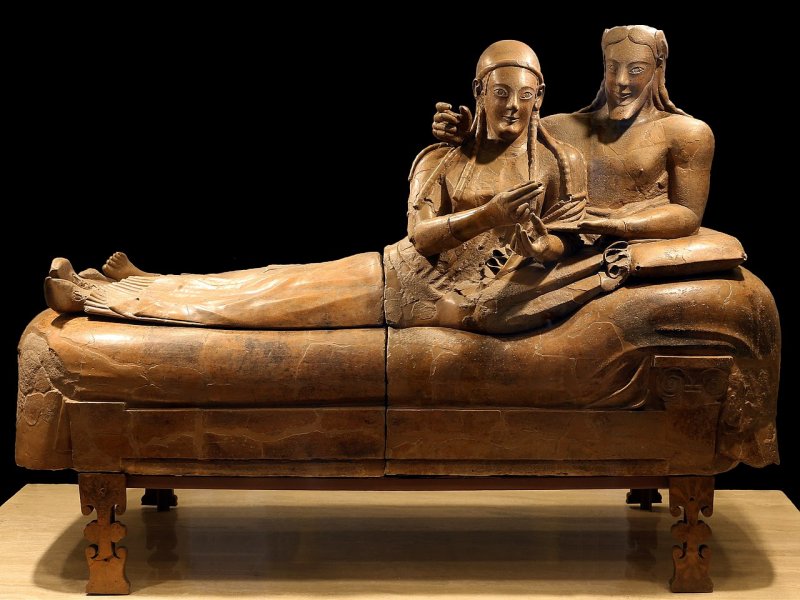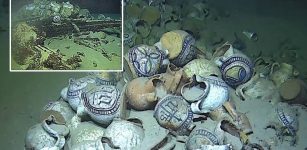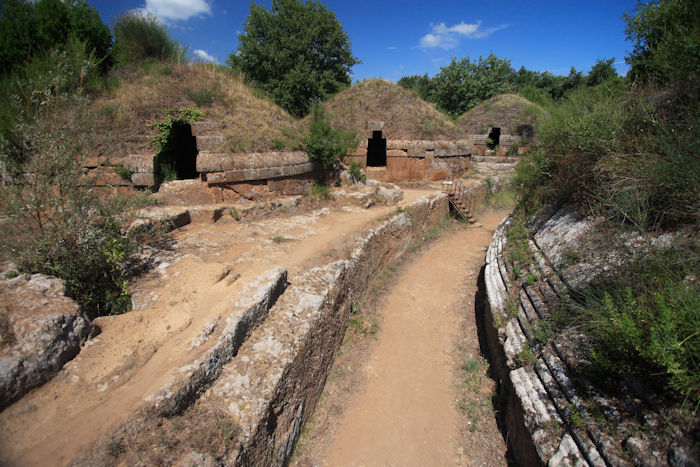Etruscan City Of Cerveteri With Magnificent House-Like Tombs Decorated With Scenes From Life And Death
A. Sutherland - AncientPages.com - Today, the town of Cerveteri is particularly famous for the numerous Etruscan cemeteries located on the surrounding hills.
Etruscan necropolis Cerveteri Rome Province, Italy. Credit: Adobe Stock - Massimo
We know about the Etruscan civilization, after being conquered by Rome, thanks to its tombs that exist in massive necropolises outside of the Etruscan cities.
Necropoli were massive graveyards in which the Etruscans buried their family members to preserve their bodies and souls. Other surviving sources of their architecture are the remains of temples, city walls, houses, and even roads carved in stone.
The ancient city of the Etruscans, Caere (now Cerveteri) was founded according to tradition by Pelasgians in c. 1400 BC.
Cerveteri, a town on the West coast of Italy, is located in the province of Rome in the Italian region Lazio, just about 40 km North of Rome.
Painting on terracotta panels of the judgement of Paris from Cerveteri (Boccanera tomb). Credit: ArchaiOptix - CC BY-SA 4.0
Known by the Etruscans as Cisra, it was once one of the metropolitan areas of the ancient Mediterranean. The Romans called it Caere, and at that time, the Etruscan city was one of the most important Etruscan cities, with an area more than 15 times larger than the town of Cerveteri, as we call it today.
A rich and powerful city was an ally of Carthage and developed good relationships with its southern neighbors, the Romans. Formed from the Villanova culture settlement, Cerveteri belonged to the Federation of 12 Etruscan cities and was one of the richest and most important in Etruria.
It flourished in the 7th century BC and the 6th century BC, thanks to maritime trade through the Etruscan ports in Altium (now known as Palo), Pyrgi (Santa Severa), and Punicum (Santa Marinella). At its height, around 600 BC, the city's population was most probably from 25,000 to 40,000 people.
Cerveteri Became Part Of A Coalition Fighting The Romans
In the 3rd century BC, Cerveteri was part of a coalition fighting the Romans; after the defeat of 273 BC, the flourishing Etruscan city lost half of its territory to pass under the authority of Rome in 90 BC.
It received only incomplete civil rights - "ius sine Suffragio" (without the right to vote). All those who lived in Caere and did not have the right to vote were called in Rome - caerites.
Due to close contact with Rome at the end of its long history, the Etruscan Caere became a sort of "satellite state" of the Roman capital and was eventually transformed into a prefecture in 273 BC.
During the decline of Etruscan cultures, also gradual decline of Cerveteri began in the 5th century BC. However, the sixth century BC marked the influence of Greek culture on Cerveteri, which became the main center of Ionian-Etruscan art.
Cerveteri And Etruscan Gigantic Tombs
Necropolises, at first glance, resemble extinct cities and house-like graves, of which some resemble the Hobbit's household. Some of them have the shape of round bunkers; others form groups of mounds.
Cerveteri's rock-cut tombs imitate beautifully decorated houses, chambers with carved furniture, and decorations like frescoes, ceramics, and ancient paintings. Cerveteri's frescoes depict scenes from the life and death of the then-living Etruscans.
The ancient artists wanted to immortalize various scenes related to hunting, erotic acts, feasting, dancing, racing, and multiple faces of demons waiting for the dead.
 Sarcophagus of the Spouses from Caere, now in the National Etruscan Museum at Villa Giulia in Rome. Image credit: Sailko - CC BY-SA 4.
Sarcophagus of the Spouses from Caere, now in the National Etruscan Museum at Villa Giulia in Rome. Image credit: Sailko - CC BY-SA 4.
All these treasures represent famous Etruscan artwork, of which one of the most famous is the Sarcophagus of the Spouses.
Religious Traditions Of Etruscan People And Network Of Corridors And Stairways
The city of Cerveteri has yet another fascinating area. It is a religious complex in the city's center, known as the "hypogeum of Clepsina," containing a network of corridors and stairways and an underground room with frescoes, sketches, and inscriptions. The hypogeum represented the cult place of the community's ancestors and the seat of rituals associated with its foundation, its destiny, and the people's religious and cosmological beliefs.
Cerveteri necropolis. Credit: Adobe Stock - francescodemarco
There is still much to discover in the region of Cerveteri, Veies, Tarquinia, or Vulci necropolises of Etruria, located in an area that covered part of what are now Tuscany, Lazio, and Umbria.
Their constructions are essential for understanding the Etruscans' mythology, religion, everyday life, and architecture.
For now, in Tarquinia, approximately 6,000 burial sites have been discovered, though not all are possible to visit and contemplate the atmosphere of ancient Etruscan people's atmosphere of life, death, and traditions.
Written by – A. Sutherland - AncientPages.com Senior Staff Writer
Copyright © AncientPages.com All rights reserved. This material may not be published, broadcast, rewritten or redistributed in whole or part without the express written permission of AncientPages.com
Expand for referencesReferences:
Haynes S. Kulturgeschichte der Etrusker
History, Captivating. The Etruscans
More From Ancient Pages
-
 How Is DNA Preserved In Archaeological Sediments For Thousands Of Years
Archaeology | Jan 3, 2022
How Is DNA Preserved In Archaeological Sediments For Thousands Of Years
Archaeology | Jan 3, 2022 -
 Ancient African Empires’ Impact On Migration Revealed By Genetics
Archaeology | Mar 31, 2023
Ancient African Empires’ Impact On Migration Revealed By Genetics
Archaeology | Mar 31, 2023 -
 World’s Oldest ‘Picture Story’ Found Deep Inside Indonesian Cave
Archaeology | Jul 8, 2024
World’s Oldest ‘Picture Story’ Found Deep Inside Indonesian Cave
Archaeology | Jul 8, 2024 -
 Mysterious Fossilized Antarctic Forest May Offer Evidence Of The Great Flood – But Some Facts Speak Against This Theory
Archaeology | Dec 27, 2017
Mysterious Fossilized Antarctic Forest May Offer Evidence Of The Great Flood – But Some Facts Speak Against This Theory
Archaeology | Dec 27, 2017 -
 Two Well-Preserved Shipwrecks Found By Swedish Maritime Divers In Baltic Sea
Archaeology | Jan 30, 2018
Two Well-Preserved Shipwrecks Found By Swedish Maritime Divers In Baltic Sea
Archaeology | Jan 30, 2018 -
 Never-Before-Seen 16 Meters Long Ancient Egyptian Papyrus Unveiled To The Public
Artifacts | Feb 21, 2023
Never-Before-Seen 16 Meters Long Ancient Egyptian Papyrus Unveiled To The Public
Artifacts | Feb 21, 2023 -
 Archaeologists Found A 16th-Century Shipwreck Of Merchant Ship Close To Saint-Tropez, France
Archaeology | Jun 13, 2025
Archaeologists Found A 16th-Century Shipwreck Of Merchant Ship Close To Saint-Tropez, France
Archaeology | Jun 13, 2025 -
 Who Was The Woman Buried With 25 Warrior Monks Of The Order Of Calatrava At The Castle At Zorita De Los Canes, Guadalajara?
Archaeology | Jun 4, 2024
Who Was The Woman Buried With 25 Warrior Monks Of The Order Of Calatrava At The Castle At Zorita De Los Canes, Guadalajara?
Archaeology | Jun 4, 2024 -
 Mystery Of The Brave Viking Chief Buried On The Gokstad Ship
Featured Stories | Mar 14, 2016
Mystery Of The Brave Viking Chief Buried On The Gokstad Ship
Featured Stories | Mar 14, 2016 -
 Nicholas Owen ‘Little John’ Who Paid Highest Price For His Ingenious, Camouflaged Places To Hide
Featured Stories | Dec 5, 2017
Nicholas Owen ‘Little John’ Who Paid Highest Price For His Ingenious, Camouflaged Places To Hide
Featured Stories | Dec 5, 2017 -
 Rare Gladiator Tombs Found In Ancient City Of Anavarza In Southern Turkey
Archaeology | Aug 16, 2022
Rare Gladiator Tombs Found In Ancient City Of Anavarza In Southern Turkey
Archaeology | Aug 16, 2022 -
 Timing Of Easter Island’s Societal Collapse – Revisited
Archaeology | Feb 7, 2020
Timing Of Easter Island’s Societal Collapse – Revisited
Archaeology | Feb 7, 2020 -
 Rakshasas: Night Wandering Race Of Demons And Warriors Fuelled By Kundalini In Hindu Beliefs
Featured Stories | Oct 8, 2019
Rakshasas: Night Wandering Race Of Demons And Warriors Fuelled By Kundalini In Hindu Beliefs
Featured Stories | Oct 8, 2019 -
 Glass Technology Was Known In Sahara Centuries Before The Arrival Of Europeans
Ancient Technology | Jan 20, 2018
Glass Technology Was Known In Sahara Centuries Before The Arrival Of Europeans
Ancient Technology | Jan 20, 2018 -
 Thousands Of Ancient Tools From A South African Cave Reveal Prehistoric Human Connections
Archaeology | Apr 11, 2025
Thousands Of Ancient Tools From A South African Cave Reveal Prehistoric Human Connections
Archaeology | Apr 11, 2025 -
 On This Day In History: Britain’s Greatest War-Time Leader Winston Churchill Died In London – On Jan 24, 1965
News | Jan 24, 2017
On This Day In History: Britain’s Greatest War-Time Leader Winston Churchill Died In London – On Jan 24, 1965
News | Jan 24, 2017 -
 Amazing Restoration Of Ancient Roman Vineyard Buried Underneath The Ash Of Mount Vesuvius For 2,000 Years
Archaeology | Nov 27, 2020
Amazing Restoration Of Ancient Roman Vineyard Buried Underneath The Ash Of Mount Vesuvius For 2,000 Years
Archaeology | Nov 27, 2020 -
 Thousands Want To Drink Red Liquid From The Granite Sarcophagus In Egypt
Archaeology | Jul 23, 2018
Thousands Want To Drink Red Liquid From The Granite Sarcophagus In Egypt
Archaeology | Jul 23, 2018 -
 Ptolemaic-Era Warship Discovered Near The Sunken City Of Heracleion In Alexandria By Underwater Archaeologists
Archaeology | Jul 20, 2022
Ptolemaic-Era Warship Discovered Near The Sunken City Of Heracleion In Alexandria By Underwater Archaeologists
Archaeology | Jul 20, 2022 -
 On This Day In History: Battle Of San Domingo Was Fought – On February 6, 1806
News | Feb 6, 2017
On This Day In History: Battle Of San Domingo Was Fought – On February 6, 1806
News | Feb 6, 2017



